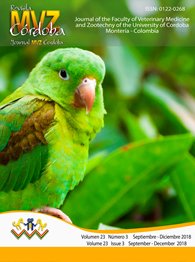Listeria sp in raw milk storage tanks in Tunja - Boyacá
Listeria sp., en cantinas de almacenamiento de leche cruda de vaca en Tunja – Boyacá
Show authors biography
Objective. To determine the relationship between the type of detergent, time use of the churn and the type of water used to wash storage churns and the presence of Listeria sp. in samples collected from storage churns of raw cow's milk, in farms of Tunja-Boyacá-Colombia. Materials and methods. 293 samples were collected by non-probabilistic sampling at convenience, in a period of time of 9 months. Isolation of Listeria sp was performed by microbiological methods and species identification using biochemical tests. A questionnaire was applied to assess the associated factors (the type of detergent, time use of the churn and the type of water used to wash storage churns). Results. The prevalence of L. monocytogenes was 2.7% (n=8). No statistically significant association was found between the variables related to cleaning of churns and the presence of L. monocytogenes. Conclusions. The existence of L. monocytogenes in raw milk was demonstrated, being the prevalence found lower than those reported in national and international studies. It is evidenced the circulation of species of Listeria sp in the dairy production chain in Boyacá. On the other hand, it is the first overview of L. monocytogenes and L. ivanovii showing the need for the implementation of control measures in the dairy industry.
Article visits 2057 | PDF visits
Downloads
- Latorre A, Van Kessel J, Karns J, Zurakowski M, Pradhan A, Boor K, et al. Biofilm in milking equipment on a dairy farm as a potential source of bulk tank milk contamination with Listeria monocytogenes. J Dairy Sci 2010; 93(6):2792-802. https://doi.org/10.3168/jds.2009-2717
- Lepe JA, Torres MJ, Liró J, Luque R, Aznar J. Caracterización microbiológica de los aislados de Listeria monocytogenes procedentes de casos humanos en Andalucía. Enferm Infecc Microbiol Clin 2012; 30(10):602-7. https://doi.org/10.1016/j.eimc.2012.02.012
- Gallegos J, Arrieta G, Máttar S, Poutou R, Trespalacios A, Carrascal A. Frequency of Listeria spp. in coastal Colombian cheeses. Rev MVZ Cordoba 2007; 12(2):996-1012.
- Camacho AC, Contreras YA, Torres PS. Incidencia de listeria monocytogenes en leche de vaca expendida en el municipio de Pamplona, Colombia. Bistua: Revista de la Facultad de Ciencias Básicas 2007; 5(2):49-57.
- Schobitz R, Ciampi L, Nahuelquin Y. Listeria monocytogenes un peligro latente para la industria alimentaria. Agro Sur 2009; 37(1):1-8. https://doi.org/10.4206/agrosur.2009.v37n1-01
- Nero LA, de Mattos MR, Barros MdAF, Beloti V, de Melo Franco BDG. Interference of raw milk autochthonous microbiota on the performance of conventional methodologies for Listeria monocytogenes and Salmonella spp. detection. Microbiol Res 2009; 164(5):529-35. https://doi.org/10.1016/j.micres.2007.04.003
- Cordier J, Putallaz T, Cox L. Impedimetric determination of activity of disinfectants and detergents on Listeria: preliminary study. Int J Food Microbiol 1989; 8(3):293-7. https://doi.org/10.1016/0168-1605(89)90030-5
- Yoshida T, Kato Y, Sato M, Hirai K. Sources and routes of contamination of raw milk with Listeria monocytogenes and its control. J Vet Med Sci 1998; 60(10):1165-8. https://doi.org/10.1292/jvms.60.1165
- Aarnisalo K, Lundén J, Korkeala H, Wirtanen G. Susceptibility of Listeria monocytogenes strains to disinfectants and chlorinated alkaline cleaners at cold temperatures. LWT-Food Sci Technol 2007; 40(6):1041-8. https://doi.org/10.1016/j.lwt.2006.07.009
- Kastbjerg VG, Gram L. Model systems allowing quantification of sensitivity to disinfectants and comparison of disinfectant susceptibility of persistent and presumed nonpersistent Listeria monocytogenes. J Appl Microbiol 2009; 106(5):1667-81. https://doi.org/10.1111/j.1365-2672.2008.04134.x
- Meloni D. Presence of Listeria monocytogenes in Mediterranean-Style Dry Fermented Sausages. Foods. 2015;4(1):34-50. https://doi.org/10.3390/foods4010034
- Simões M, Simões LC, Vieira MJ. A review of current and emergent biofilm control strategies. LWT-Food Sci Technol 2010; 43(4):573-83. https://doi.org/10.1016/j.lwt.2009.12.008
- Weiler C, Ifland A, Naumann A, Kleta S, Noll M. Incorporation of Listeria monocytogenes strains in raw milk biofilms. Int J Food Microbiol. 2013;161(2):61-8. https://doi.org/10.1016/j.ijfoodmicro.2012.11.027
- Vásquez FCM, Martínez GR, Mancera VMM, Ávila LEO, Vargas MR. Análisis microbiológico y su relación con la calidad higiénica y sanitaria de la leche producida en la región del Alto de Chicamocha (departamento de Boyacá). Revista de Medicina Veterinaria 2007; 14:61-83.
























